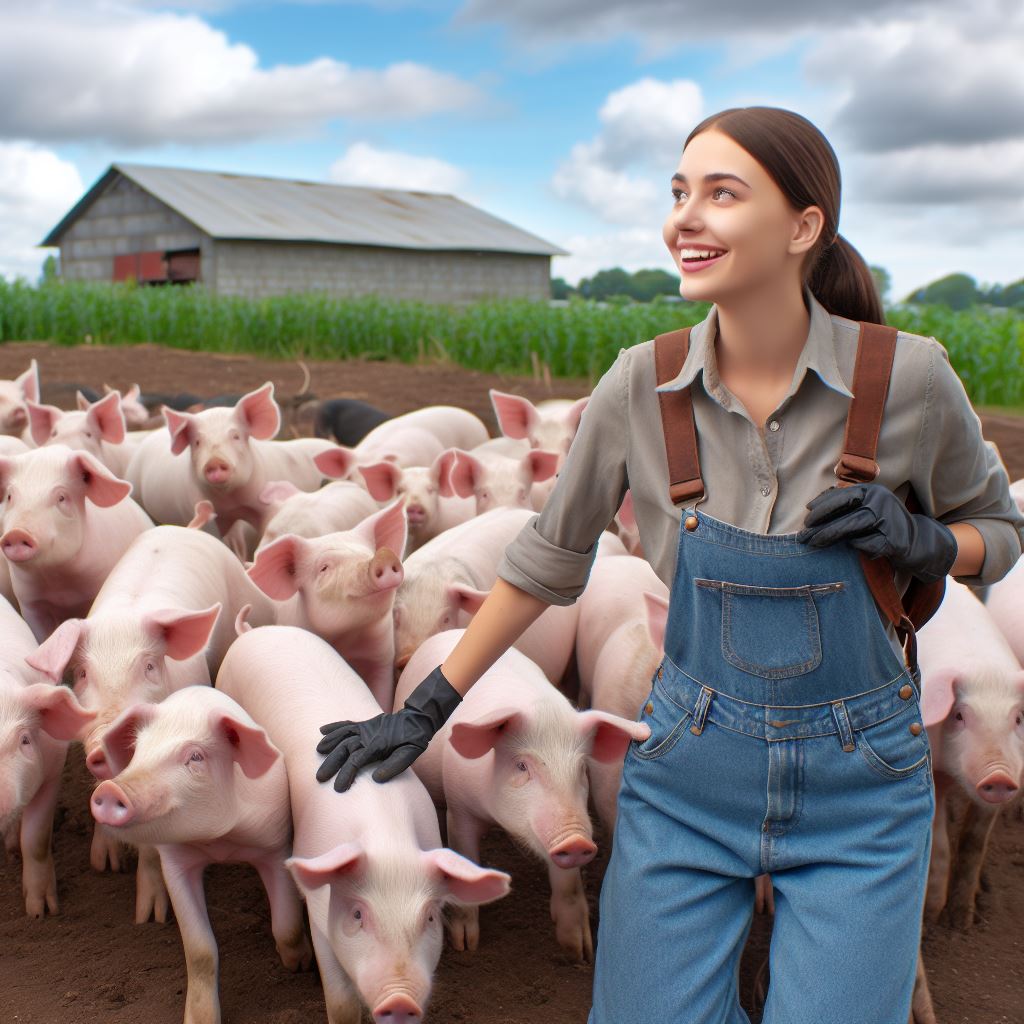Introduction
A. Brief overview of goat rearing
Goat rearing is the practice of raising and caring for goats for various purposes.
With low initial investment and efficient resource utilization, goat farming offers economic benefits, making it a valuable livestock enterprise for farmers worldwide.
B. Importance of goat rearing for farmers
Goat rearing is crucial for farmers as it provides them with multiple benefits and opportunities for sustainable income.
Goats are resilient, adaptable, and require less space and investment.
Their products contribute to food security, poverty alleviation, and rural economic development, enhancing overall farm sustainability.
Selecting the Right Breed
A. Consideration of climate and environment
- Research and evaluate the climate conditions and environment in your area.
- Choose a goat breed that can adapt and thrive in your specific climate and environmental conditions.
- Consider factors such as temperature, rainfall, humidity, and available grazing lands.
- Ensure that the breed you select has the ability to withstand any extreme weather conditions in your area.
- Consult local experts or experienced goat rearers for advice on suitable breeds for your climate and environment.
B. Determining goals and purpose for rearing goats
- Define your goals and expectations for rearing goats, whether it’s for milk production, meat, fiber, or companionship.
- Consider the size of your operation and the resources, time, and commitment you can allocate.
- Identify the market demand and profitability of the specific goat products or services you aim to provide.
- Select a goat breed that aligns with your goals and offers the potential for achieving desired outcomes.
- Be realistic about your capabilities and ensure your goals are attainable within your circumstances.
C. Understanding the characteristics and requirements of different goat breeds
- Research and familiarize yourself with the various goat breeds available.
- Take into account the desired traits such as milk production, meat quality, fiber yield, or hardiness.
- Familiarize yourself with the specific health and nutritional requirements of each breed.
- Consider the temperament and behavior of different goat breeds to find one that matches your handling abilities.
- Evaluate the space and housing requirements for the selected breeds, ensuring adequate room for their specific needs.
- Consult breed associations, fellow goat rearers, or agricultural extension offices for more information on different breeds.
Choosing the right breed is critical for the success of your goat rearing venture.
Considering the climate, environment, goals, and characteristics of different goat breeds will help you make an informed decision.
Take the time to research, seek advice, and carefully evaluate your options before selecting the breed that best suits your needs and resources.
Setting Up Proper Housing and Facilities
A. Building or modifying a suitable shelter for goats
- Choose a shelter location that provides protection from extreme weather conditions and allows for easy access.
- Construct or modify the shelter to provide adequate space for each goat, allowing them to move freely.
- Ensure that the shelter is well-insulated to maintain a comfortable temperature for the goats.
- Use durable materials to build the shelter, ensuring it can withstand the wear and tear from goats.
- Install proper flooring that is easy to clean and maintain, such as concrete or gravel.
B. Ensuring proper ventilation and adequate space
- Provide good ventilation by incorporating windows, vents, or fans in the shelter to prevent the buildup of moisture and odors.
- Ensure that the shelter has sufficient air circulation, as poor ventilation can lead to respiratory problems in goats.
- Avoid overcrowding by providing adequate space for each goat, allowing them to rest, move, and exhibit natural behaviors.
- A general rule of thumb is to provide at least 10-15 square feet of shelter space per goat.
C. Designing fencing and security measures
- Install sturdy and secure fencing around the grazing area to prevent goats from wandering off or predators from entering.
- Use materials such as woven wire, electric fencing, or high-tensile wire to ensure the strength and durability of the fence.
- Regularly inspect and maintain the fence to ensure there are no gaps or weak spots that could compromise the security of the goats.
- Consider adding additional security measures such as motion sensor lights or a guard dog to deter potential threats.
In summary, setting up proper housing and facilities for goats is crucial for their well-being and overall success in goat rearing.
By building or modifying a suitable shelter, ensuring proper ventilation and adequate space, and designing effective fencing and security measures, goat farmers can provide a safe and comfortable environment for their animals.
This, in turn, promotes their health, reduces stress, and contributes to better overall results in goat rearing.
Read: Sustainable Livestock Farming Tactics
Providing Nutritious and Balanced Diet
A. Understanding the Dietary Needs of Goats
- Goats are ruminant animals and require a diet that is high in fiber.
- Roughage, such as hay and pasture, should form the basis of their diet.
- Goats also need access to minerals, vitamins, and trace elements to maintain good health.
- It is important to provide a diet that meets the specific nutritional requirements of each goat.
B. Offering a Variety of Forage and Supplementary Feeds
- Goats should have access to a variety of forage, including grass, legumes, and browse.
- Offering a diverse range of forage helps meet their nutritional needs and keeps them interested in eating.
- In addition to forage, goats may also require supplementary feeds, such as grain or concentrates.
- Supplementary feeds should be given in moderation and balanced according to the goat’s requirements.
C. Providing Clean and Fresh Water
- Water is essential for goats’ overall health and proper digestion.
- Provide clean and fresh water at all times, especially during hot weather and lactation.
- Make sure water troughs are clean and easily accessible to all goats in the herd.
- Monitor water intake to ensure each goat is drinking an adequate amount.
D. Avoiding Common Feeding Mistake
- Do not overfeed goats, as it can lead to obesity and other health problems.
- Avoid sudden dietary changes that can cause digestive upsets and metabolic disorders.
- Ensure proper storage of feed and forage to prevent mold growth and contamination.
- Regularly monitor the body condition score of each goat and adjust the diet accordingly.
Overall, providing a nutritious and balanced diet is crucial for the overall well-being of goats.
Understanding their dietary needs, offering a variety of forage and supplementary feeds, providing clean and fresh water, and avoiding common feeding mistakes are essential for achieving the best results in goat rearing.
Read: Livestock Management: Diverse Animal Care
Transform Your Agribusiness
Unlock your farm's potential with expert advice tailored to your needs. Get actionable steps that drive real results.
Get StartedHealth and Disease Management
A. Regular vaccination and deworming schedules
Regular vaccination and deworming are crucial for maintaining the health and well-being of goats.
Vaccinations protect them from various diseases, while deworming helps eliminate internal parasites.
It is important to follow a specific vaccination schedule recommended by a veterinarian.
This schedule ensures that goats receive the necessary immunizations at the appropriate times.
All vaccines should be stored properly and administered according to the manufacturer’s instructions.
Deworming should be done regularly to prevent parasite infestations.
Various dewormers are available, and the choice of dewormer depends on the specific parasites prevalent in the area.
Consult a veterinarian to determine the most effective deworming protocol for your goats.
B. Identifying common health issues in goats
Being able to identify common health issues in goats is essential for their well-being.
Early detection enables prompt treatment, minimizing the chances of complications.
Some common health problems in goats include respiratory infections, diarrhea, parasites, and nutritional disorders.
Regularly observing your goats for signs of distress, such as coughing, runny nose, or changes in behavior, can help identify potential health issues.
Performing regular physical examinations on your goats can also aid in detecting problems.
Check for signs of lameness, abnormal stool consistency, discharge, or abnormal coat condition.
C. Importance of quarantine and hygiene practices
Implementing quarantine and practicing good hygiene are vital to prevent the spread of diseases among your goat herd.
When introducing new goats to an existing herd, it is crucial to quarantine the newcomers for a specific period.
This helps prevent the transmission of any potential diseases they may be carrying.
Quarantine should involve keeping the new goats in a separate area with minimal contact with the existing herd.
Maintaining good hygiene practices is necessary to prevent the spread of diseases within the herd.
This includes regular cleaning and disinfecting of feeders, water troughs, and living areas.
Proper waste management and avoiding overcrowding are also essential.
D. Consulting a veterinarian for necessary treatments
For any health issues or treatments beyond regular vaccinations and deworming, it is important to consult a veterinarian.
Veterinarians are trained professionals who can diagnose and prescribe appropriate treatments for various goat health conditions.
They can provide accurate advice on nutrition, vaccines, parasite control, and other aspects of goat care.
Showcase Your Farming Business
Publish your professional farming services profile on our blog for a one-time fee of $200 and reach a dedicated audience of farmers and agribusiness owners.
Publish Your ProfileBuilding a good working relationship with a veterinarian is beneficial for the overall health and well-being of your goats.
Regular check-ups and consultations can help prevent or treat potential health problems effectively.
In general, maintaining optimal health and disease management in goats requires regular vaccination and deworming, identifying common health issues, implementing quarantine and hygiene practices, and consulting a veterinarian when necessary.
By prioritizing their health, you can ensure the well-being of your goats and achieve the best possible results in goat rearing.
Read: Tech in Farming: Innovations in Livestock Care

Breeding and Reproduction
A. Understanding the breeding cycle of goats
Goats are seasonal breeders, with breeding season typically occurring in the fall.
It is important to track the estrus cycle of female goats to determine the best time for breeding.
Signs of estrus in female goats include restlessness, tail wagging, and increased vocalization.
B. Selecting suitable breeding stock
Choose healthy and genetically superior goats for breeding to ensure healthy offspring.
Assess the breed characteristics and traits of potential breeding stock.
Consider the age, size, and overall condition of the goats before making a breeding selection.
C. Proper mating techniques and pregnancy management
- Ensure that the mating process occurs naturally, or use artificial insemination by a professional.
- Provide a proper breeding area that is clean, well-maintained, and separate from other goats.
- Monitor the pregnancy progress by observing physical changes and consulting with a veterinarian.
- Proper nutrition, including a balanced diet rich in minerals and vitamins, is essential during pregnancy.
D. Care for newborn kids and post-birth considerations
- Ensure a clean and warm environment for newborn kids to prevent hypothermia.
- Allow the dam to bond with her kids and monitor their nursing and feeding patterns.
- Provide adequate colostrum, or the first milk, to newborn kids within the first few hours of birth.
- Watch for any signs of illness or weakness in the kids and seek veterinary assistance if necessary.
- Vaccinate and deworm the kids according to recommended schedules to protect their health.
Breeding and reproduction are crucial aspects of goat rearing, and understanding the breeding cycle is fundamental.
When selecting suitable breeding stock, prioritize the health and genetic superiority of the goats.
Implement proper mating techniques, ensuring a clean and suitable breeding area, and considering natural or artificial insemination.
Pregnancy management involves monitoring the progress and providing the dam with a nutritious diet.
Care for newborn kids should emphasize a warm and clean environment, proper bonding with the dam, and timely colostrum intake.
Vigilance in monitoring their health and administering necessary vaccinations and deworming is essential for their well-being.
By following these breeding and reproduction tips, goat farmers can maximize their breeding success and ensure healthy offspring for their herd.
General Care and Maintenance
Achieving best results in goat rearing involves providing proper care and maintenance for your goats.
Here are some essential tips:
A. Regular grooming and cleanliness
- Brush your goats regularly to remove dirt, debris, and loose fur from their coats.
- Keep their living area clean by regularly removing feces and soiled bedding.
- Inspect your goats’ skin for any signs of parasites or infections and treat as necessary.
- Trim their hair around the eyes, ears, and udders to prevent irritation and infections.
- Bathe your goats only when necessary using goat-friendly shampoos and warm water.
B. Providing suitable bedding materials
- Choose appropriate bedding materials such as straw, wood shavings, or sawdust.
- Ensure the bedding is clean, dry, and free from molds or sharp objects that may harm the goats.
- Change the bedding regularly to maintain a clean and hygienic living environment.
- Provide enough bedding to keep your goats comfortable, especially during colder seasons.
- Monitor the goats’ bedding to prevent the accumulation of parasites like mites or lice.
C. Monitoring and addressing behavioral or social issues
- Observe your goats’ behavior regularly to identify any signs of stress, aggression, or sickness.
- Separate or isolate goats that display aggressive or bullying behavior towards others.
- Provide enough space and resources to reduce competition and minimize stress among goats.
- Introduce new goats gradually, allowing them to establish a hierarchy without excessive fighting.
- Consult a veterinarian or animal behaviorist if you encounter persistent behavioral issues.
D. Basic hoof care and trimming
- Regularly inspect your goats’ hooves for signs of overgrowth, injury, or infections.
- Trim their hooves every 6-8 weeks using proper hoof trimming tools like hoof shears or a trimmer.
- Ensure the trimming process is done carefully and avoid cutting into the sensitive parts of the hoof.
- Apply antiseptic or hoof care products after trimming to promote healing and prevent infections.
- Provide a clean and dry surface for your goats to prevent hoof problems like thrush or foot rot.
By following these general care and maintenance tips, you can ensure the well-being and productivity of your goats, ultimately leading to the best results in goat rearing.
Read: Boosting Goat Health: Nutrition & Care Tips
See Related Content: High-Tech Fencing Solutions for Livestock Safety
Marketing and Selling Goats
A. Identifying potential markets for goat products
- Conduct market research to identify potential customers interested in buying goat products.
- Look for local restaurants and gourmet food stores that may be interested in serving or selling goat meat.
- Explore online platforms and social media groups dedicated to sustainable farming and animal products.
- Attend agricultural trade shows and networking events to connect with potential customers.
B. Establishing a marketing strategy
- Determine your unique selling points and create a compelling brand story for your goat products.
- Develop a professional website and online presence to showcase your products and attract potential buyers.
- Utilize social media platforms to engage with customers, share updates, and promote your goat products.
- Create eye-catching packaging and labeling that highlights the quality and benefits of your goat products.
C. Developing a strong network of buyers
- Build relationships with local chefs, butchers, and grocery store owners who are interested in goat products.
- Collaborate with other goat farmers to collectively market and sell your products to a wider customer base.
- Participate in farmers’ markets, food festivals, and community events to directly connect with potential buyers.
- Offer samples of your goat products to allow customers to taste the quality and flavor.
D. Ensuring legal compliance and documentation
- Research and comply with all local, state, and federal regulations regarding goat product sales.
- Obtain necessary permits, licenses, and certifications required for selling goat products.
- Keep accurate records of sales, receipts, and expenses for tax purposes.
- Clearly label your products with all required information, including farm or producer identification, processing dates, and nutritional facts.
In essence, successful marketing and selling of goats require careful planning and execution.
Identifying potential markets, establishing a marketing strategy, developing a strong network of buyers, and ensuring legal compliance are key steps towards achieving the best results.
By implementing these strategies, goat farmers can effectively market and sell their products, reaching a wider audience and maximizing their profits.
Uncover the Details: Maximizing Profit in Small Scale Poultry
Conclusion
A. Recap of key points discussed
In this section, we discussed important tips for best results in goat rearing.
We covered various topics such as selecting the right breed, providing proper nutrition, maintaining a clean environment, and ensuring adequate healthcare for the goats.
B. Encouragement for prospective goat rearers
If you are considering starting a goat rearing business, it is important to remember that with dedication and proper implementation of these tips, you can achieve success.
Goat rearing has the potential to be a profitable and rewarding venture.
C. Importance of continuous learning and improvement
To ensure the best results in goat rearing, it is crucial to continuously educate yourself and seek opportunities for improvement.
Stay updated on new techniques, advancements in healthcare, and best practices that can enhance your goat rearing operation.
By staying informed and implementing the knowledge gained, you can increase productivity, reduce risks, and maximize the overall success of your goat rearing enterprise.
Remember, goat rearing requires patience and persistence. Embrace challenges as opportunities to learn and grow.
With dedication and continuous improvement, you can achieve the best results and have a thriving goat rearing business.




